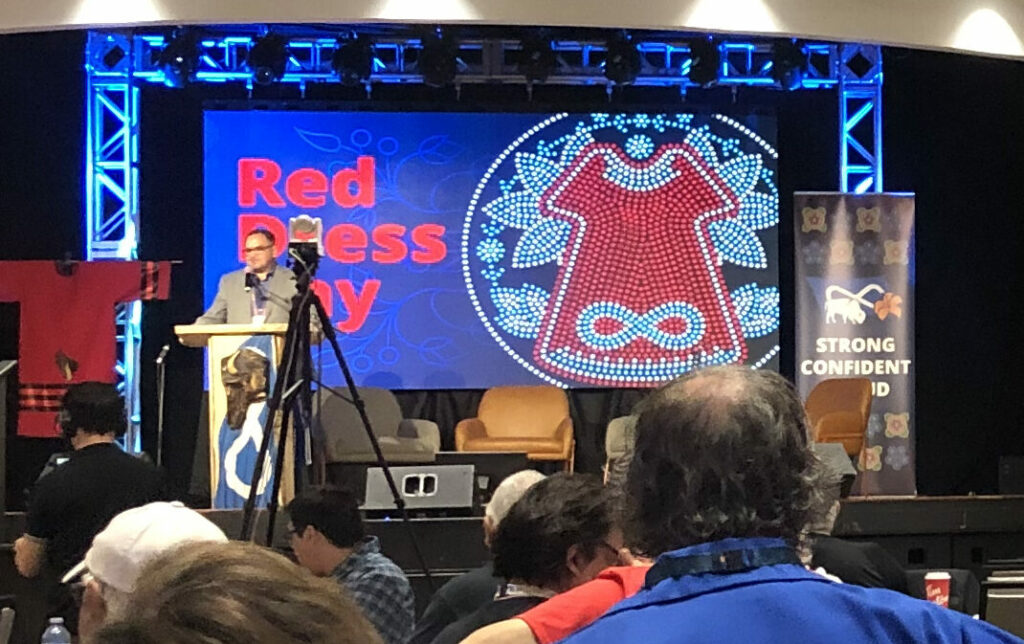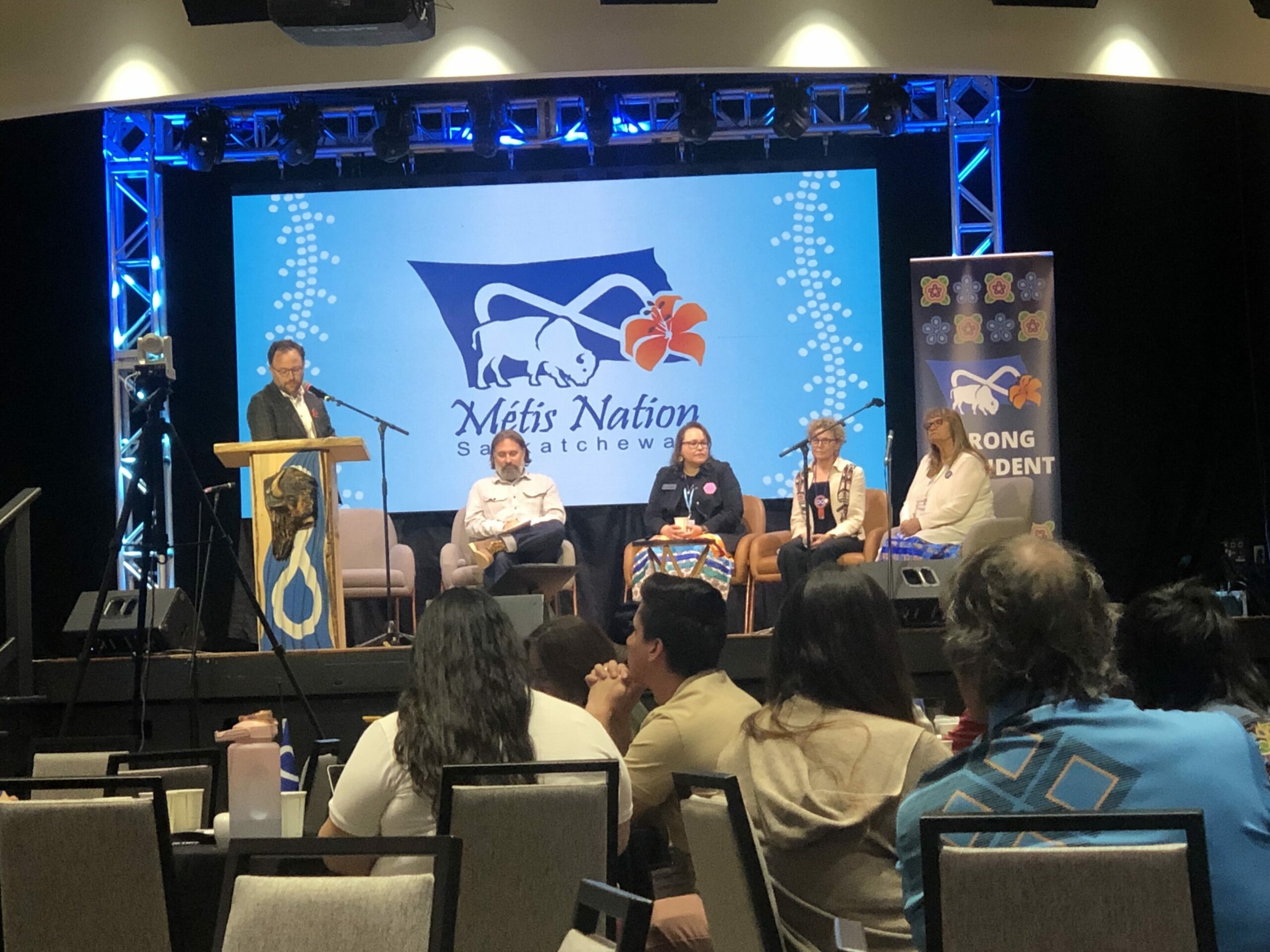In my first month working with Métis Nation-Saskatchewan (“MN-S”), my deepest and most fulfilling learning experiences arguably occurred whilst I was passing around microphones, handing out name tags, and jotting down notes. How is that possible, you ask? Well, it turns out that as interesting as it is to do legal research, nothing beats learning directly from Métis people.
As an intern at MN-S, I have already had several chances to learn directly from Métis people. In my first week, I had the privilege to attend MN-S’ Métis Rights Conference on UNDRIP (United Nations Declaration on the Rights of Indigenous Peoples). The team at my office had been working hard to prepare this event for months, and I swooped in at the perfect moment—mostly to sit back and learn. Then, just a few weeks later, I attended the semi-annual Métis Nation Legislative Assembly (MNLA), and accompanying dialogue forums. Both events were incredible opportunities to hear from Métis citizens and their elected representatives in real life.

Why Métis Self-Government Matters
Since the 1930s, MN-S has represented Métis collective interests within Saskatchewan, operating as a non-profit organization since 1993.[1] In 2019, however, the federal government recognized not only that Saskatchewan Métis have a right to self-government, but also that MN-S was their appropriate representative.[2] Now, it is no longer appropriate to call MN-S an “organization” or non-profit. It is not merely an interest group representing loosely associated people to the Canadian government. Rather, MN-S is its own self-governing nation.
What does this mean? To begin, it might be relevant to note what it does not mean: a threat to Canadian sovereignty or to the continued prosperity of non-Indigenous folks on this land. As stated in UNDRIP, Indigenous self-determination need not diminish a nation’s “territorial integrity or political unity”[3]. Although this statement is not uncontroversial, Dr. Brenda Gunn explained at the Conference how it might make sense. Neither Canada’s territorial integrity nor its political unity are relevant to Indigenous people’s demands. Métis aren’t seeking to redefine Canadian geographic borders. Métis self-determination isn’t about non-Indigenous people at all.
Rather, Métis self-determination is about Métis. MN-S’ job is to represent and support Métis within Saskatchewan, and to address their distinct needs.
This is especially crucial given the enduring legacy of colonialism.
Métis history is marked by unfulfilled Canadian government promises. When Manitoba was formed, Métis were promised land under the Manitoba Act, 1870—more than 1.4 million acres.[4] Yet Canada did not fulfill its promise. 15 years later, in 1885, it set up the scrip system. Scrip refers to vouchers in the place of land, which Métis were entitled to but often effectively deprived of—by manipulative land speculators and a system which prevented Métis from bringing claims to justice.[5] Because this land-related injustice was never truly resolved, it still has an impact today.
Furthermore, Métis endured residential and day schools, followed by the Sixties Scoop.[6] In fact, more than a decade after the 2007 residential school settlement agreement,[7] many Métis survivors still have not been compensated.[8] Notably, the boarding school at Île-à-la-Crosse is not a recognized residential school. Yet students there suffered in many of the same ways at other residential schools: they were malnourished, deprived of their home, culture, language, and identity, and often psychologically, physically, and sexually abused. Similarly, other institutions, including orphanages and mental health institutions, are also the sites of unmarked Métis graves—yet have not been recognized as such.
At the MNLA, we watched a documentary put together by Métis survivors. I looked around the room and recognized many of those in the Assembly. It stopped me in my tracks to realize that these politicians whose space I was sharing were residential school survivors.
Delayed compensation often practically means no compensation. Unfortunately, as many Île-à-la-Crosse survivors are elderly or have passed on, they will never receive compensation. This injustice is difficult to understand.
The intergenerational trauma from residential schools and other forms of colonialism manifests itself in concrete ways in Métis communities. Métis children are 8.3 times more likely than their non-Indigenous peers to be in foster care.[9] Métis are also more likely to experience housing and food insecurity.[10] And their culture remains threatened. Broken lines of connection between parents and displaced children have left lasting impressions. Today, only 0.5% of Métis youth are fluent Michif speakers.[11]

Colonial damage also manifests itself through human loss: Missing and Murdered Indigenous Women and Girls (MMIWG). Shockingly, the exact number of missing Métis women and girls is uncertain because data exists regarding MMIWG in general, but not Métis specifically.[12] The Métis Rights Conference took place on Red Dress Day, a day of remembrance for MMIWG. MN-S held a special ceremony in recognition of this sombre day.
Métis self-government is crucial because of this colonial legacy—scrip, residential schooling, and the ways intergenerational trauma manifests today. Colonial governments’ repeated failures to fulfill Métis needs demonstrates that Métis people need something else. As the government by, for, and of the Saskatchewan Métis, MN-S attempts to fill that need. It’s not a simple endeavour—being a government means acting in everything from housing to education to environment. Yet from what I have witnessed, I can honestly say that MN-S is doing it. It’s impressive.
Reimagining Environmental Justice as Grounded in Real Community Needs
Working for MN-S has opened my eyes to a whole new meaning of environmental justice—the kind of justice that is not only relevant but utterly necessary to the people that live on and depend on the land.
A month ago, I’d never talked to anyone, apart from my grandpa in Sweden, who hunts for food. Living in Montreal, that reality feels pretty distant. By contrast, here in Saskatoon, I have encountered many Métis who continue to hunt, fish, trap, or gather, often taught to do so by their parents or grandparents. In fact, I work alongside several Métis university student interns, and was impressed to discover that many of them also hunt.
I also made a more sobering discovery: the extent to which Métis hunting rights remain unprotected. Decided in 2003, R v Powley[13], the leading Canadian case for Métis rights, revolved around the following fact pattern: two Métis men are charged for hunting moose without a valid hunting licence. The Canadian Supreme Court found that these men and their community had the right to hunt for food.[14] This right flowed from Section 35 of the Constitution Act, which protects aboriginal rights, and the Court says “reflects a new promise: a constitutional commitment to protecting practices that were historically important [to communities]”[15].
Today, in 2023, 20 years after Powley, has that promise been realized? No. Unlike other Indigenous peoples, Métis have no established land base—with the exception of eight Métis settlements in Alberta.[16] This means that many Métis harvesting rights, though existing in theory, are not actualized. In practice, Métis harvesting rights require a court judgement to confirm that this particular community has historic hunting rights in this particular area.[17]
Métis citizens at the Métis Rights Conference described experiences almost identical to the facts in Powley: despite having hunted on a piece of land for generations, following the practices of their grandparents, they found themselves arrested and charged for hunting without a licence. They presented their Métis citizenship card in defence—often to little avail.
In the office, I have been tasked with compiling Métis rights jurisprudence. Almost half the cases I read sound virtually identical to Powley.
Two decades after Powley promised Métis constitutional rights, they remain elusive. As Métis are continuously charged and fined for hunting infractions, they are forced to spend money, time, and energy away from the land they live on, in court. Furthermore, some fail to meet the evidentiary burden to establish their rights.[18]
I came to law school dreaming about pursuing environmental justice. Yet I’m still learning what that means. Before I heard directly from Métis that live on the land, I couldn’t anticipate what issues would be important to them. Now, I’m beginning to understand.
When your basic rights to exist and subsist the way your ancestors did—rights you were promised decades ago—still are not recognized, that is your priority. Then, to implement that right, we can and should talk about environmental conservation and climate change. After all, it is crucial that these rights remain sustainable for generations to come. In that sense, Métis harvesting rights are inextricable from other environmental questions. But they are also, at least to those for whom they are life, necessarily a first priority. MN-S cannot do much about conservation or climate change before Saskatchewan recognizes its people’s basic rights.
This makes Métis harvesting rights an important precondition to environmental justice in Saskatchewan. This might seem backwards to some environmental advocates. Yet I truly believe that environmental justice means little without concrete considerations regarding human rights and needs.

Métis Rights Conference Panel Discussion
Final Thoughts
My first month with MN-S has been profoundly eye-opening. I am so grateful for this opportunity. Not only have I learnt a lot from the incredible events I just described, but I am also learning a lot in my daily work at the office. My coworkers at MN-S are a fantastically kind, passionate and interesting group of people. I want to thank them for welcoming me to this team!
Postscript: A Note on my Own Positionality
When I started at MN-S, I was quite hung up over my own positionality as a non-Indigenous person in spaces for Métis citizens. I am trying to let go of that hang-up. Although honesty and transparency are crucial, I want to learn from and uplift community voices, rather than get hung up on my own. By constantly reminding people of my whiteness, I only refocus the conversation on myself. This tension can be challenging to navigate, but doing so also feels vital to ensuring that what I do and learn here means something for this community.
[1] See Constitution of the Métis Nation – Saskatchewan, (1993), online (pdf): <www.metismuseum.ca/media/document.php/148507.Boucher%20030.pdf>. See especially ibid, art 1.
[2] See Métis Nation within Saskatchewan Self-Government Recognition and Implementation Agreement, 24 February 2023, Preamble section K, online (pdf): Métis Nation-Saskatchewan, <metisnationsk.com/wp-content/uploads/2023/02/MNS_FED-SGRIA_02-24-2023.pdf>.
[3] See United Nations Declaration on the Rights of Indigenous Peoples, GA Res 61/295, 61st Sess, Supp no. 53 (A/61/53), UN Doc A/RES/61/295 (2007) at art 46.
[4] See Indigenous and Northern Affairs Canada, Thomas Isaacs, A Matter of National and Constitutional Import: Report of the Minister’s Special Representative on Reconciliation with Métis: Section 35 Métis Rights and the Manitoba Metis Federation Decision, at pp 8–9 (Ottawa: Indigenous and Northern Affairs Canada, 2016) [Thomas Isaac’s report]; Manitoba Metis Federation v Canada (AG), 2013 SCC 14, at paras 26–28, 30.
[5] See Thomas Isaac’s report, supra note 4 at 9; Kyle Muzyka, “What’s Métis scrip? North America’s ‘largest land swindle,’ says Indigenous lawyer” CBC News (13 February 2020), online: <www.cbc.ca/radio/unreserved/from-scrip-to-road-allowances-canada-s-complicated-history-with-the-métis-1.5100375/what-s-métis-scrip-north-america-s-largest-land-swindle-says-indigenous-lawyer-1.5100507>.
[6] See Métis Nation-Saskatchewan, Les Femmes Michif Otipemisiwak, Métis Perspectives of Missing and Murdered Indigenous Women, Girls and LGBTQ2S+ People, at pp 27–31 (Ottawa: Les Femmes Michif Otipemisiwak, 2019) [Les Femmes Michif Otipemisiwak].
[7] Crown-Indigenous Relations and Northern Affairs Canada, Indian Residential Schools Settlement Agreement, online: <www.rcaanc-cirnac.gc.ca/eng/1100100015576/1571581687074>.
[8] See e.g. Sam Samson, “Île-à-la-Crosse, Sask. boarding school survivors push for recognition in their lifetimes” CBC News (6 March 2023), online: <www.cbc.ca/news/canada/saskatchewan/île-à-la-crosse-boarding-school-survivors-push-for-recognition-in-lifetime-1.6763946>.
[9] See Les Femmes Michif Otipemisiwak, supra note 6 at 52.
[10] See e.g. Les Femmes Michif Otipemisiwak, supra note 6 at 31–32.
[11] I learnt this at the conference.
[12] See generally Les Femmes Michif Otipemisiwak, supra note 6.
[13] 2003 SCC 43 (Powley).
[14] Ibid.
[15] See Powley, supra note 14 at para 45.
[16] See Thomas Isaac’s report, supra note 4 at 22.
[17] See Powley, supra note 14 at paras 49–50. See e.g. R v Belhumeur, 2007 SKPC 114.
[18] See e.g. R v Norton, 2005 SKPC 46.
